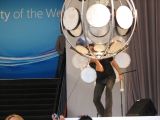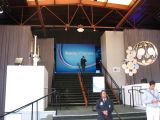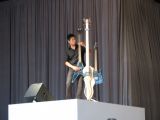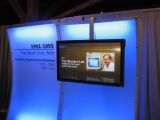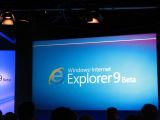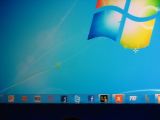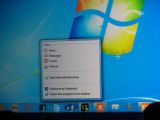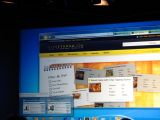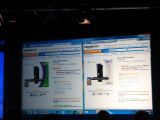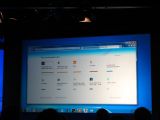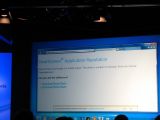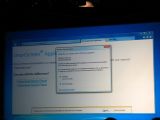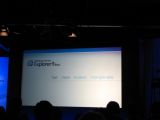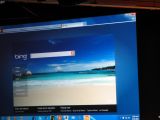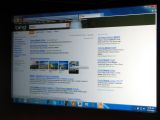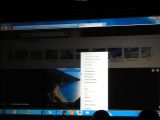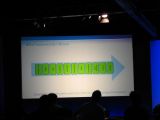Forget everything you know about Microsoft’s browser. With the release of Internet Explorer 9 (IE9), Internet Explorer has become something else entirely. No longer is IE the exception to the rule in terms of the browsing world, instead look for it at back in the position of leader in innovation.
September 15th is a truly historic day for Microsoft and IE, marked by the release of IE9 Beta. Build 9.0.7930.16406 was launched earlier today at the Beauty of the Web event in San Francisco, California, and is currently available for download.
Internet Explorer 9 is fundamentally different, with the IE team having labored extensively to rearchitect the browser.
And fact is that there’s no reason to beat around the bush on this, IE9 is a fantastic release, comparable with the evolution from Windows Vista to Windows 7.
There’s really no other way of putting it, users who liked Windows 7 will love IE9. Better yet in fact, they will love the level of deep integration between Windows 7 and IE9.
Yhey wanted the software giant to listen, well, it did. IE9 is the culmination of feedback harvested from end users, developers and partners.
The next iteration of Internet Explorer is extremely fast; features a new, overhauled UI with simplicity and ease of use as core concepts; sports advanced modern web standards support; delivers enhanced tabbed browsing; new Windows UI integration options; hardware –acceleration; and many many new other features.
Let’s start on the surface
After all, the UI is the first thing that users will come across. And the redesigned UI of IE9 is all about putting user experiences in the focus by pushing the browser into the background.
By default, Internet Explorer 9 gives a tremendous amount of screen real estate space to users, with Microsoft having trimmed the fat, so to speak, and keeping only the most essentials of controls.
Early adopters already familiar with the Platform Preview releases of IE9, know that Microsoft shipped the developer releases without even the most basic UI elements.
It turns out that the Platform Previews were, well, a preview of the Beta. IE9 features just two buttons on the left hand side, with the websites’ favicon being displayed on the far left.
Then there's the all-in-one One Box, which plays the roles of both the Address Bar and the Search field normally placed close to the right hand side corner.
The One Box, as you might have guessed it, is designed to offer search and navigation functionality, in a concept that is not necessarily new, but does come with a twist customers are bound to love.
Users can enter an URL into the One Box, hit Enter, and they will navigate to a website, but the evolution of the Address Bar/ Search Box is capable of delivering so much more.
Namely, search capabilities, but not just for search engines, also for the browsing history, and for favorites.
While the One Box is capable of offering suggestions from search engines, this is turned off by default, as IE9 protects the privacy of its users, by not sharing everything they type to search providers.
Microsoft’s concern for privacy alone is one of the reasons I’m recommending it over rival browsers that offer similar functionality, while disregarding customers’ right to not have everything they type in One Box equivalents phoned home to the search provider.
In the IE9 Beta default configuration the rest of the UI elements are switched off, but users can still enable the Favorites bar, Command bar, and Status bar.
In IE9 new tabs open to the right of the One Box . This can lead to a bit of overcrowding, especially if end users are used to opening up a lot of websites simultaneously.
Dean Hachamovitch, Corporate Vice President, Internet Explorer, Microsoft, revealed this morning that only about 9% of users have opened eight or more tabs concomitantly.
So the software giant optimized the browser for the remainder of 92% of customers that are really limiting the number of opened tabs during their browser sessions to less than eight.
But the core aspect of the IE9 UI revamp is connected to the Redmond company’s efforts to make the browser only a subtle presence for Cloud applications that otherwise look and feel like native Windows apps.
In this context, there are a range of enhancements that really blur the line between web-based and desktop-based applications.
IE9 users will be able to pin websites on the Windows 7 taskbar, just as they do with Windows apps. The Taskbar will show the site’s favicon, and will also deliver the same line of eye-candy and effects to the pinned items as for actual applications, including adapting the color to mouse-over events in relation to the favicon’s predominant color.
Of course, since we’re talking about Windows 7’s taskbar, developers can make sure that once one of their website’s is pinned to the desktop, it will come with its own mini-Start menu. Yes, pinned IE9 sites can have JumpLists.
And is JumpLists can be associated with a IE9 pinned site on the Windows 7 Taskbar, Thumbnail Preview should make no exception, should they?
Well, the fact of the matter is that they actually make no exception. Users can potentially control some aspects of sites, such as playing media, right from the Thumbnail Preview on the Windows 7 Taskbar.
Pinned sites can also get icon overlays, allowing devs to deliver additional information to end users on top of the actual favicon/icon on the Taskbar.
In addition, the Redmond company has also worked to ensure that users get the best UX possible with IE9 and Aero Snap.
Customers running Windows 7 have undoubtedly used Aero Snap in order to easily place windows side by side, by grabbing each window and dragging it to either side of the screen.
This is not possible with individual Internet Explorer 9 Tabs. Not only do tabs tear off in IE9, but they can be snapped to either side of the desktop without the process affecting the content being displayed in any manner, a detail which has the next version of IE outpacing its rivals.
An important change for Internet Explorer’s UI revolves around the Notification Bar. With the advent of IE9, notifications will no longer be delivered at the top of the screen, but at the bottom instead.
The new notification experience is designed to be as little disruptive as possible, and as users will undoubtedly notice, in certain scenarios it will come very easy for them to actually ignore the notification and continue browsing.
Opening a new Tab in IE9 delivers an entirely new, and extremely improved experience over its predecessor.
The new tab will display a range of suggestions to users, based on their browsing habits, but also allow them to reopen closed tabs, recover sessions and kick off InPrivate browsing.
Let’s look under the hood
Despite the ergonomic design, IE9’s beauty is more than just skin deep. Dare I say that for Internet Explorer 8, the real beauty of the web promised by Microsoft is connected to the browser’s under-the-hood goodies.
But in this respect, there aren’t really any new features on top of what the software giant already delivered with the four Platform Previews released thus far.
IE9 is unlike any of its rival, in the sense that it offers developers advanced support for HTML5, Scalable Vector Graphics (SVG), Cascading Style Sheets Level 3 (CSS3), ECMAScript5 and DOM.
IS there more work to be done? Certainly! But at the same time, standards like HTML5 are yet to be completed, and until such a point, there will always be more that the software giant can do.
As far as HTML5 is concerned, IE9 supports video and audio, as well as canvas elements, while acceleration al content through the GPU.
Hardware acceleration is a really big deal for Microsoft, with IE9 being the first, and so far only hardware-accelerated browser on the market, despite claims to the contrary by rivals.
But it doesn’t stop with HTML5. There is now support for Document Object Model Level 2 (DOM L2) and Level 3 (DOM L3), but also for elements such as DOM L2 and L3 Core, DOM L2 Views, DOM Element Traversal, DOM L2 and L3 Events, DOM L2 HTML, DOM L2 Style, DOM L2 Traversal and Range, and WebIDL.
The software giant did not content itself with delivering a browser that was just compliant with the Cascading Style Sheets Level 2.1 (CSS2.1) specification.
This is why Internet Explorer 9 also plays nice with CSS3, with support for a variety of new features from modules including Backgrounds & Borders Module, Color Module, Fonts Module, Media Queries Module, Namespaces Module, Selectors Module, the Values & Units Module, and support for the Web Open Font Format (WOFF).
IE9 has been tailored to the latest iteration of JS, and not only this, but IE9’s DOM actually comes with native support for ECMAScript 5.
Another aspect of Microsoft really listening to developer and partner input and delivering is related to support for vector graphics on the web.
But IE9 does not only support SVG, it also accelerates all SVG content by default.
And let’s not forget that while some aspects of Internet Explorer 9 have only been improved in comparison to its predecessor, such as networking, others have been built from scratch.
IE9 got a new optimized document object model (DOM), as well as a fresh JavaScript engine, codenamed Chakra.
There is a range of work that went into boosting the performance of IE9, and more powerful DOM and JS, in combination with parallel capabilities and hardware acceleration means that users will get a level of speed never before seen with an IE release.
And then there are even more features
Had enough? Didn’t think so. Although a tad overdue, IE finally offers users a Download Manager.
In all fairness, Microsoft is making it up to customers by integration the IE9 Download Manager close with the SmartScreen Filter.
Just like Notifications Bar, the Download Manager opens at the bottom of the screen, and comes with basic functionality such as pausing and resuming downloads, or canceling them altogether.
The SmartScreen filter throws interesting capabilities in the mix by introducing download reputation. By judging the reputation of certain files, IE9 can block potentially malicious downloads, without bothering users with false positives or generic warnings that end up being ignored.
The new Add-on Performance Advisor will also notify users at the bottom of the screen when a browser extension will impact negatively the performance of the browser.
Essentially, the feature is designed to inform users that performance is affected for all add-ons that take longer than 0.2 seconds to load.
One thing is clear, add-ons developers will need to really step up their game and increase the quality of their extensions, or risk becoming outcasts from IE9.
The good old Compatibility View is back yet again. As was the case with the Platform Preview Builds, the IE9 Beta development milestone, and later releases, will feature multiple document modes designed to keep the browser compatible with legacy content.
The Compatibility View feature will function in the same manner as it does in IE8, meaning that users will get to play with the Compatibility View button, still.
And speaking of comebacks, Tab isolation has also evolved in IE9. And in addition to having every tab run in its own process, and allowing for individual tab recovery in the eventuality of a crash, IE9 also introduces Hang Recovery.
Tabs that hang will no longer be a problem as they will not impact the overall performance of the browser.
Try it while it’s hot
Internet Explorer 9 Beta is the hottest thing on the Internet right now. Even if you prefer a rival browser, make sure to download Build 9.0.7930.16406 and take it out for a spin. This browser is guaranteed to surprise you.
Internet Explorer 9 (IE9) Build 9.0.7930.16406 is available for download here.
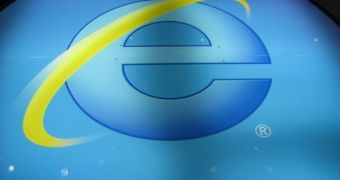
 14 DAY TRIAL //
14 DAY TRIAL // 


